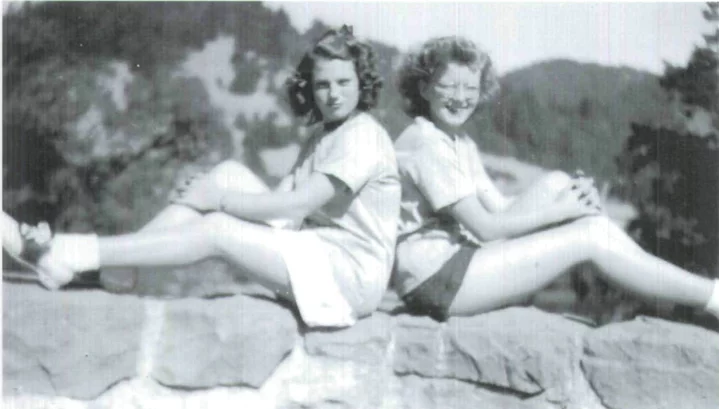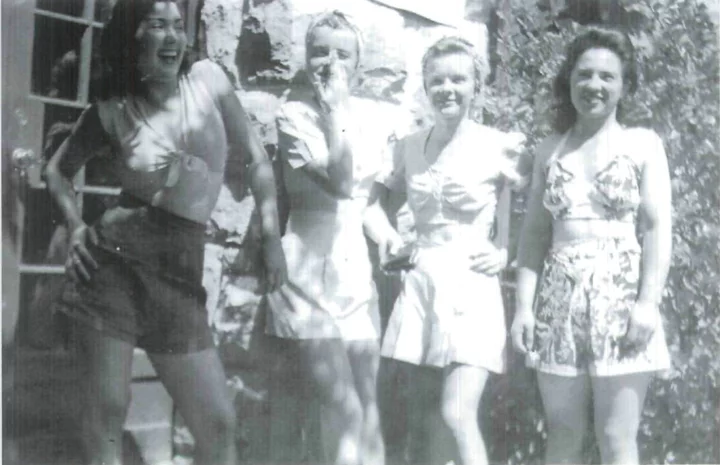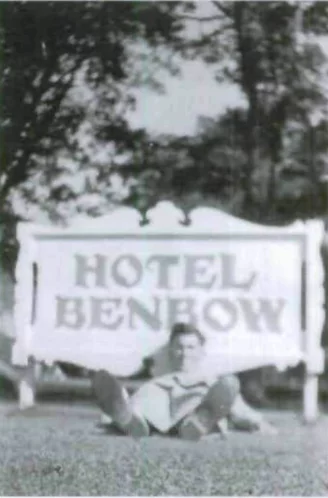The author’s sister, Betty Olsen (left), and Shirley Sweet pose on the stone bridge that arched over Lake Benbow, Summer 1945. Photos courtesy of Naida Gipson, via the Humboldt Historian.
Every day during the late spring semester of 1945 I checked the bulletin board at Humboldt State College for a summer job. One morning, among the usual babysitting jobs and truck drivers’ positions, a help wanted notice appeared for waitresses and bellboys at the Benbow Inn near Garberville. My sister, Betty, and I were hired — with no interviews. The fact that I was a student satisfied any reference requirements.
The inn was designed for the Benbow family by Albert Farr, the architect who created author Jack London’s “Wolf House” in Glen Ellen. California. The nine Benbow brothers and sisters constructed a dam to form Benbow Lake and built a power company to provide electricity. Benbow Inn opened in 1926 and became a vacation land for movie stars like Jeanette MacDonald and Alan Ladd, and important people such as Eleanor Roosevelt and Herbert Hoover. It was a popular stop for motorists on the recently completed Redwood Highway. During its early days, some guests flew to the hotel in small airplanes, using the road for a landing strip. My sister had hoped to see her favorite movie stars, but the closest we came to seeing a celebrity was serving a guest who looked like Clark Gable.
Mother bought our bus tickets, round trip to San Francisco with layovers at Benbow, for $6.26 each, and two white uniforms at $1.98 apiece. We packed our beige and blue striped cardboard suitcases and caught the Greyhound bus for Southern Humboldt County.
All my life I had looked out for my little sister, and, at seventeen I felt responsible for her. Betty would not be sixteen, the legal age for employment, until October, and I think should have had a work permit, but the Benbow sisters who ran the hotel did not question this. Help was so hard to get during the war that they were glad to have us, with or without a work permit.
After a two-hour ride from Eureka, the Greyhound bus pulled up in front of the inn, brakes hissing, diesel engine rumbling. We took our suitcases from the overhead racks and stepped down into the hot sunshine. The bus left in a cloud of exhaust. The inn loomed before us. We carried our suitcases up the curved steps to the main lobby. One of the Benbow sisters, a large woman with black hair, probably in her fifties, emerged from a little office and informed us the help did not use the front entrance. She showed us the servants’ entrance at one corner of the ground floor basement level that housed a post office, storerooms and a kitchen where the workers ate.
Miss Benbow then led us up the servants’ narrow stairs to the third-floor attic. Bellboys and maintenance men lived in a building on the bank of the Eel River, a few hundred yards from the inn. She showed us to our room tucked up under the roof with a slanted ceiling and a dormer window looking out over the curved driveway, and gave us towels and sheets and blankets to make up the two single beds. She pointed out the bathroom and the laundry, where we were to do our personal laundry by hand. Then she went back downstairs.
Four of the summer waitresses at Hotel Benbow in the summer of 1945. The first two girls on the left are unidentified; third from, left is Winnie Hogue, who was then a student at Humboldt State; fourth from the left is Georgeanne - called “George the girl” by her colleagues. Georgeanne’s last name is also unknown.
The other girls living in the attic crowded into our room, laughing and talking. I recognized Shirley Sweet and Winnie Hogue from Humboldt State College, but I did not know the other girls, and now I can’t remember their names except for Georgeanne, whom we called “George the Girl.” That night when we went to bed, I felt a big hole in the center of my mattress made by some sort of small animal, maybe a pack rat. I shivered and curved my body around the hole, not sure it would be all right to ask for another mattress.
The eldest Benbow sister, slender and gray, supervised the dining room. Meals were included in the room fees of $15.42 per day on the American plan. No menus or sales slips. We memorized the menu and the daily changes, and recited it to the guests. Orders were not written down. I found that if I looked directly at the person ordering, I could remember everything, including drinks: coffee, hot tea, iced tea, or milk, and cream, sugar or lemon for coffee or tea. We were all underage, and were not allowed to serve alcohol.
Guests wore nice, casual clothing in the dining room. Coats and ties were not required. Although the Benbow sisters ate in the dining room at the table closest to the kitchen called “the family table,” people working at the inn did not eat in the dining room. We had our own cook in the basement kitchen. The day that country sausage patties were served, I sat next to a gardener, gnarled and worn from working hard all his life, who told me not to eat the sausage as it had spoiled in the hot weather. I didn’t eat it and told Betty not to eat it, either.
Once in a while, a guest would ask if we thought something on the menu was good. At first, I honestly told them we didn’t get to eat the dining room food. Later, I learned to say it was all very good. The chef personally made his specialty for dinner, miniature baking powder biscuits served in small Pyrex pie plates, piping hot, right out of the oven, an individual plate of hot biscuits for each table. More, if they wanted them. The guests raved about the biscuits, but I wondered why. All my life, my mother had made biscuits. Even I could make biscuits.
The stairway from the lower kitchen to the main floor rose steep and narrow, with room for only one person at a time. One day as I climbed to the main floor, one of the workmen followed me. He noticed the heels of my white socks had been mended. In our house, nothing was wasted, and my mother spent evenings with a full darning basket. She mended socks by slipping a darning egg inside the sock so the hole could be supported, and sewed cotton embroidery thread back and forth across it one way, and then in a basket weave across the other way, making an even patch. When we reached the main floor, the man laughed and asked me who had darned my socks. I thought of the hours my mother had worked. Close to tears I said. “My mother.”
A small soundproof room about ten feet wide separated the kitchen from the dining room. One set of swinging doors led to and from the kitchen, and another set of swinging doors led to and from the dining room, effectively insulating the kitchen noises from the guests. Soiled table linens were deposited in a large bin built into one side of this room. Shelves above the bin held clean silverware and linens.
Tray service with heavy silver dish covers took some practice to handle. Silver coffee and teapots added to the weight of the trays. We learned to scrunch down, get one shoulder under the tray and then stand straight up. balancing the load with one hand. In our free hand, we carried a tray stand and pushed the swinging doors open. Traffic had to keep to the right or we would have had collisions with loaded trays. One day as Betty came through the swinging door her heavy tray became unbalanced and crashed to the dining room floor. She dissolved into tears. Unruffled, the eldest Benbow sister called a bellboy to clean it up. She took Betty back into the kitchen to repeat the order for the chef. Miss Benbow handled the disaster so smoothly, she must have had some experience with crashed trays.
The number of waitresses fluctuated, but there were usually eight. We worked a three-split shift, six days in a row with the seventh day off. However, there were not always enough girls to do this, so sometimes we worked straight through our day off.
The day started at 6:30 with breakfast, but we were not all needed at that hour, so we took turns with only one or two going early. The rest of the girls arrived in the dining room at 8 a.m. When breakfast was over at 10 a.m., two girls stayed to put fresh linens and heavy silver place settings on the tables. Then we were free until noon, when we started the second part of our split shift — lunch between 12 noon and 2 p.m.
After serving lunch, two girls stayed to put clean linen and silver on the tables, and we were free until dinner from 6 p.m. to 9 p.m., the last part of our three-split shift. Again, two girls stayed late to reset the tables. When it was Betty’s and my turn to stay late, we sang in two-part harmony the songs we had always sung at home while doing dishes, except that at home with another sister to help, the harmony had been three-part, like the Andrews Sisters, a popular wartime trio. We sang songs of the forties that Bing Crosby sang, such as “The San Fernando Valley” or “I’m an Old Cowhand” and other oldies from the twenties and thirties like “Blue Skies” or “It Had to Be You.”
We soon learned the rules at Benbow Inn. No fraternizing with the guests. The lobby and broad staircase to the second floor rooms were for guests only. We used the servants’ stairway that went from the basement to the third-floor attic. Canoes and swimming were available on the lake for guests, but we were forbidden to go there. If we wanted to swim, we walked down a dusty gravel road and swam in the river. One of the waitresses had a Model A Ford. Once in a while, in our off hours, we piled into her car and headed for Richardson Grove, a few miles south of Benbow, and a special place for teenagers during the ‘40s. Young people and families from all over Humboldt County camped among the old growth redwoods, where outdoor dances were held in a pavilion under the trees. The Eel River lazed along in the hot sun beyond the shaded grove.
A sweet old lady, whom we were told had been coming to the Inn for years, always tipped 10 cents. Breakfast, lunch or dinner, the girl serving her table could count on a ten-cent tip. One evening I waited on the man who looked like Clark Gable. He left a fifty-cent tip.
Betty and I had babysat for a neighbor in Eureka who gave us matching shorts and blouse outfits made from a cotton tropical print fabric of deep red palm trees and red-and-yellow thatched huts. The cropped blouses tied in front, leaving a bare midriff, a World War II fashion. We wore our new outfits one day when we all planned to go to Richardson Grove, and waited at the bottom of the the entrance steps for the other girls. Clark Gable’s look-alike walked down the stairs with his friends, stared at us, laughed and said, “Where’d you get those outfits? A fire sale?” His companion, a pretty blonde woman dressed in cream-colored silk slacks and blouse, her make-up perfect with bright red lipstick drawn outside the lip line the way movie stars did, laughed too. My face burned. I didn’t know what a fire sale was, but I knew it wasn’t good. 1 turned around, ran back up four flights of stairs, changed into something else and gave my wild tropical print outfit to Georgeanne. The guest’s comment didn’t bother Betty. She continued to wear her outfit all summer.
One night, Betty slipped out with the other girls and the boys to paddle the canoes around forbidden Benbow Lake, oars muffled, giggles stifled. Since I was responsible for my younger sister, I was afraid she would get into trouble and be sent home. Betty had always been more daring than I. From the shadows of the garden, I watched in agony while they all floated around in the moonlight. After an eternity, they drifted back and tied up the canoes, grinning, giggling and stumbling over each other in the dark. To my great relief, they did not get caught.
Betty and I had agreed to work at the Benhow Inn until the second week in August, when we planned to take the Greyhound bus to the San Francisco Bay Area to visit our aunt. We had worked hard most of the summer and wanted to see our cousins and shop for school clothes in San Francisco. The night before we were to leave, I went to the office to pick up our pay. The Benbow sister in charge of payroll, the same one who had shown us the servants’ entrance that first day, refused to give me our money. They were short- handed. We had already worked eight days in a row, with no time off. Maybe she thought if she didn’t pay us, we would have to stay on a while longer, but our aunt and cousins were expecting us in San Mateo the next evening. I went into the soundproof room between the kitchen and the dining room and tried to figure out what to do.
The elder Benbow sister happened to walk through the little room and found me crying into the laundry bin. I blurted out my problem. She went to her sister and got our money for me, but she didn’t know we had worked through our day off. We never did get paid for that extra day — a little more than $4 each — not much now, but a small bonanza to us then and worth about forty- one dollars apiece in 2005.
Betty and I waited in the sun with our cardboard suitcases when the Greyhound bus pulled into driveway of the hotel the next day. When we reached San Francisco, we had to go to another terminal to catch the bus to San Mateo. During World War II, everybody carpooled, and we hailed a nearly full cab. The driver said he could squeeze in two more. He got out of the cab to put our suitcases into the trunk, and I nearly dropped mine on his toes. The Benbow Inn guest who had tipped me fifty cents, the man who had laughed at my “fire sale” outfit, the one who looked like the movie star, Clark Gable, reached for my suitcase. We both stopped short. Then we laughed, and he put my suitcase into the trunk.
We piled into the cab. Betty on my lap, and reached the other terminal in time to catch our bus to San Mateo.
###
The story above was originally printed in the Summer 2005 issue of the Humboldt Historian, a journal of the Humboldt County Historical Society. It is reprinted here with permission. The Humboldt County Historical Society is a nonprofit organization devoted to archiving, preserving and sharing Humboldt County’s rich history. You can become a member and receive a year’s worth of new issues of The Humboldt Historian at this link.



CLICK TO MANAGE